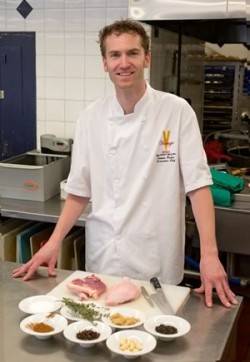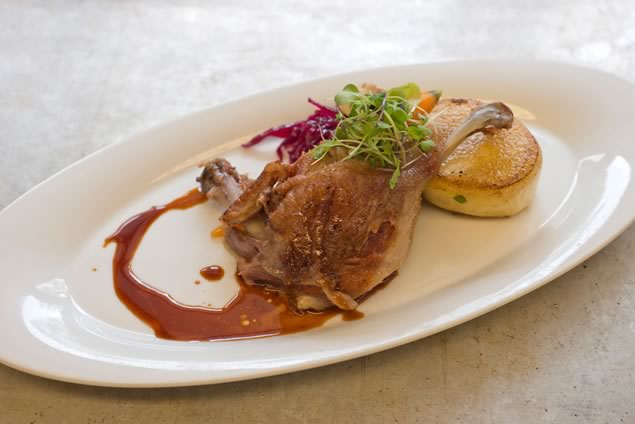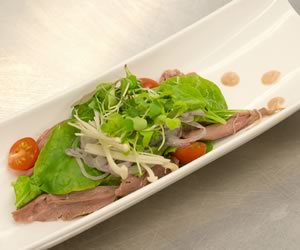Cooking with James: Duck Confit
Preparing duck confit is not difficult, but it is time consuming and requires patience, technique and even love.

James Buder, chef at The Millcroft Inn, demonstrates how to prepare succulent duck confit. Photo by Pete Paterson.
Any chef can make foie gras and beef tenderloin taste amazing because, in a way, they already are. But to take a challenging food like duck and make it extraordinary is what I really love to do. Duck legs are naturally tough and sinewy because the duck uses them so much. As a result, they require long, slow cooking at a low temperature to ensure they are not rubbery. If properly prepared, the meat will be moist, buttery and extremely flavourful.
The term “confit” comes from the French word confire, which means “to preserve.” A specialty of southwestern France, particularly the Occitan region, it is usually prepared from the legs of geese or ducks by slowly cooking the cured meat in its own rendered fat and allowing it to cool. If this centuries-old technique is properly followed, confit will last about six months in the refrigerator without spoiling.
Remember to season the meat generously with salt and herbs distributed evenly on all surfaces of the legs. After allowing it to cure in the refrigerator for two days, be sure to carefully wash off all the seasonings. Even traces of garlic or thyme could turn rancid during the cooking process. It is also very important to dry the duck thoroughly before placing the legs in the fat to cook. A few minutes in a moderate oven, just until it begins to brown, will ensure it is completely dry.
Then it can be submerged in the liquefied duck fat. A rule of thumb is the fat should cover the duck legs by at least one inch. This may seem like a lot of fat (and it is), but duck fat can be kept indefinitely in the refrigerator and reused for many dishes.
The most important part of making confit is to remember “slow and low.” After about two hours or more in a 250° to 275°F oven, check for doneness by inserting a skewer. If it meets little resistance, the confit is done and ready to be stored.
When you’re ready to eat it, allow the duck to come to room temperature before removing from the solidified fat. Brown it carefully in a frying pan and serve. I suggest accompanying it with braised red cabbage and lightly fried potatoes. Confit is also wonderful served cold in a salad with baby greens and a savoury dressing.
Preparing duck confit is not difficult, but it is time consuming and requires patience, technique and even love. Investing time, care and passion will result in something really memorable, which is what we strive for daily.
Related Recipes

Spiced Duck Confit
Aug 17, 2012 | | Back IssuesConfit is also wonderful served cold in a salad with baby greens and a savoury dressing.







